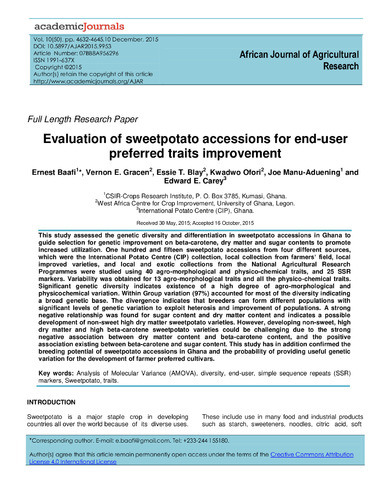Evaluation of sweetpotato accessions for end-user preferred traits improvement
Abstract
This study assessed the genetic diversity and differentiation in sweetpotato accessions in Ghana to guide selection for genetic improvement on beta-carotene, dry matter and sugar contents to promote increased utilization. One hundred and fifteen sweetpotato accessions from four different sources, which were the International Potato Centre (CIP) collection, local collection from farmers’ field, local improved varieties, and local and exotic collections from the National Agricultural Research Programmes were studied using 40 agro-morphological and physico-chemical traits, and 25 SSR markers. Variability was obtained for 13 agro-morphological traits and all the physico-chemical traits. Significant genetic diversity indicates existence of a high degree of agro-morphological and physicochemical variation. Within Group variation (97%) accounted for most of the diversity indicating a broad genetic base. The divergence indicates that breeders can form different populations with significant levels of genetic variation to exploit heterosis and improvement of populations. A strong negative relationship was found for sugar content and dry matter content and indicates a possible development of non-sweet high dry matter sweetpotato varieties. However, developing non-sweet, high dry matter and high beta-carotene sweetpotato varieties could be challenging due to the strong negative association between dry matter content and beta-carotene content, and the positive association existing between beta-carotene and sugar content. This study has in addition confirmed the breeding potential of sweetpotato accessions in Ghana and the probability of providing useful genetic variation for the development of farmer preferred cultivars

